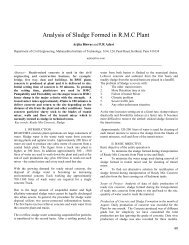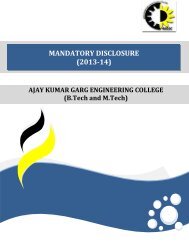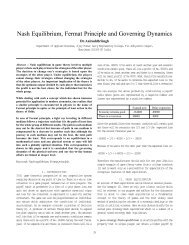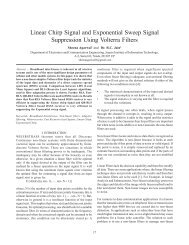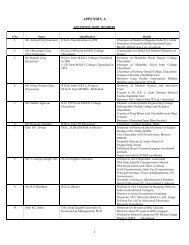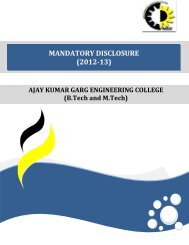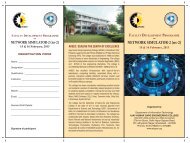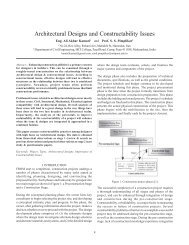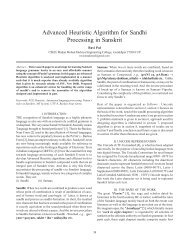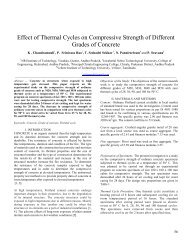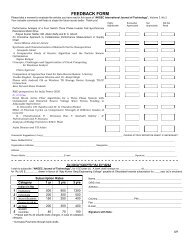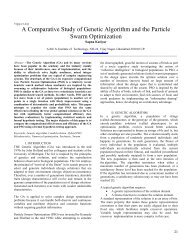5-Atul Sood.pmd - Ajay Kumar Garg Engineering College
5-Atul Sood.pmd - Ajay Kumar Garg Engineering College
5-Atul Sood.pmd - Ajay Kumar Garg Engineering College
- No tags were found...
Create successful ePaper yourself
Turn your PDF publications into a flip-book with our unique Google optimized e-Paper software.
DIRECT TORQUE CONTROL OF PMSM DRIVEdetermined by the status of the three switches, S a, S band S c. Ifthe switch is at state 0 that means the phase is connected to thenegative and if it is at 1 it means that the phase is connected tothe positive leg.Figure 3. Voltage Space Vectors.Table I SWITCHING TABLEFigure 4. VSI connected to the R-L load.The output of the torque hysteresis comparator is denoted asô, the output of the flux hysteresis comparator as ø and the fluxlinkage sector is denoted as è. The torque hysteresiscomparator is a two valued comparator; ô = 0 means that theactual value of the torque is above the reference and out of thehysteresis limit and ô = 1 means that the actual value is belowthe reference and out of the hysteresis limit.The flux hysteresis comparator is a two valued comparator aswell where ø = 1 means that the actual value of the flux linkageis below the reference and out of the hysteresis limit and ø = 0means that the actual value of the flux linkage is above thereference and out of the hysteresis limit. We define ø and ô tobe the outputs of the hysteresis controllers for flux and torque,respectively, and θ (1) -θ (6) as the sector numbers to be usedin defining the stator flux linkage positions. In Table I, if ø = 1,then the actual flux linkage is smaller than the reference value.On the other hand, if ø = 0, then the actual flux linkage is greaterthan the reference value. The same is true for the torque.IV. GENERATION OF VOLTAGE SPACE VECTORThe estimation of the stator flux linkage components requiresthe stator terminal voltages. In a DTC scheme it is possible toreconstruct those voltages from the DC link voltage, Vdc, andthe switching states (S a, S b, S c) of a six-step voltage-sourceinverter [2]. When the primary windings are fed by an inverter,as shown in Fig. 3, the primary voltages va, vb and vc areFor example, va is connected to Vdc if Sa is one, otherwise vais connected to zero. This is similar for vb and vc. The voltagevectors that are obtained this way are shown in Fig.2. Thereare six non-zero voltage vectors: V 1(100) , V 2(110) …, andV6(101) and two zero voltage vectors: V7(000) and V8(111).The six nonzero voltage vectors are 60 degree apart from eachother as in Fig. 2.V. VOLTAGE VECTOR SELECTIONIN DTC OF PMSM DRIVEControl strategy adopted for selection of appropriate voltagevector is based on the Table II. On the basis of the sector è(è=1, 2. . . 6) in which the stator flux linkage lies and of themagnitude of the errors of the torque and flux , a voltage spacevector V i(with i = l, 2, .. 6 ) is generated as shown in the fig. 4.Figure 5. Voltage vector selection when the statorflux vector is located in sector i.25
AKGEC INTERNATIONAL JOURNAL OF TECHNOLOGY, Vol. 3, No. 1As shown in Fig. 5, while the stator flux vector is situated insector i, voltage vectors V i+1and V i-1have positive directcomponents, increasing the stator flux amplitude, and V i+2andV i-2have negative direct components, decreasing the statorflux amplitude.Fig.5 Voltage vector selection when the statorflux vector is located in sector IMoreover, V i+1and V i+2have positive indirect components,increasing the torque response, and V i-1and V i-2have negativeindirect components, decreasing the torque response. In otherwords, applying V i+1increases both torque and flux but applyingi+1 increases torque and decreases flux amplitude.constant = 0.476wb, Motor Moment of Inertia = 0.000423 kgm2 , Damping coefficient = .0004012 kg-m 2 /s. The commandsignal for the torque is taken as a step change changing from1N-m to 2N-m at 0.1s.The simulation is performed using the actual values of thestator flux and torque and then comparing it in the respectivehysteresis comparator. As shown in fig.6, the output of thesetwo comparators, in addition to the sector selector is thenapplied to the switching table to obtain the best possible voltagevector.VI. SIMULATION AND RESULTSMATLAB/Simulink model of the permanent magnetsynchronous motor is developed using two-level inverter. The2 pole motor parameters used for simulation are Statorresistance (R S) = 9.76 Ù, Direct axis self inductance (Lsd) = 92mH, Quadrature axis self inductance (Lsq) = 126mH, Rotor fluxFigure 8. Flux Trajectory.Figure 6. Flux trajectory.Figure 7. Harmonic Spectrum of stator current for two level inverter.Figure 9. Harmonic spectrum of Stator current forthree level inverter.26
DIRECT TORQUE CONTROL OF PMSM DRIVEMatlab implementation Direct Torque Control Technique withboth 2-level and 3-level inverter are done and results for boththe cases are presented. The stator current i aspectrum forthree level inverter is shown. The spectrum when comparedwith the spectrum of i awith two level inverter the THD% hasbeen reduced to 20.97% and also the fundamental componenthas been increased to 1.109.Hence simulation results provethat the use of 3-level inverter instead of 2-level inverter inDTC technique results in lower ripple content in torque, statorflux and stator currents.VII. REFERENCES[1] M. Depenbrock, “Direct Self – Control (DSC) of Inverter FedInduction Machine”, IEEE Trans. Power Electronics, Vol. 3,No 4, October 1988.[2] Enrique L. Carrillo Arroyo “Modeling and Simulation ofPermanent Magnet Synchronous Motor Drive system”, Ph.Dthesis, University of Puerto Rico Mayagüez campus. 2006.[3] Cui Bowen, Zhou Jihua, Ren Zhang, “Modeling and Simulationof Permanent Magnet Synchronous Motor Drive” Fifth IEEEInternational Conference on Electrical Machines and Systems,Volume 2, Aug. 2001.[4] B. K. Bose, “Power Electronics and AC drives”, Prentice HallInc., Englewood Cliffs, New Jersey, 1986.[5] Cui Bowen, Zhou Jihua, Ren Zhang “Modelling and Simulationof Permanent magnet Synchronous motor Drives”, IEEEproceedings 1990.[6] R. Krishnan, “Electric Motor Drives: Modelling, Analysis andControl”, Prentice-Hall of India Private Limited, New Delhi,2005.[7] L. Zhong, M. F. Rahman, “A Direct Torque Controller forPermanent Magnet Synchronous Motor Drives”, IEEE Trans.Energy Conversion, Vol. 14, No.3, September, 1999.[8] S. Dan, F. Weizhong, H. Yikang, “Study on the Direct TorqueControl of Permanent-Magnet Synchronous Motor Drives”,Fourth IEEE International Conference on Power electronicsand Drive System, October 22-25, Bali, Indonesia, p. 571-574.[9] L. Zhong, M. F. Rahman, W.Y. Hu, K.W. Lim, “Analysis ofDirect Torque Control in Permanent Magnet SynchronousMotor Drive”, IEEE Trans. Power Electronics, Vol. 12, No.3,May, 1997.[10] Salih Baris Ozturk “Modelling, Simulation and Analysis ofLow-cost Direct Torque Control of PMSM using HALL-EFFECT sensors”, Ph.D thesis, Texas A&M University,December 2005[11] D.Casadei, Francesco Profumo, Giovanni Serra, Angelo Tanni,“FOC and DTC: two viable schemes for Induction MotorTorque control”, IEEE Trans. on Power Electronics. 2001.[12] LANG Bao-hua, LIU Wei-guo, ZHOU Xi-wei, LI Rong,“Research on Direct Torque Control of Permanent MagnetSynchronous Motor Based on Optimized State Selector”,IEEE ISIE Volume 3, 9-13 July 2006.[13] Rahman MF, Zhong L. “Voltage switching tables for DTCcontrolled interior permanent magnet motor”, IECON’99, 25thannual Conference June 1999. p. 1445–51.[14] Maurizio Cirrincione , Marcello Pucci, Gianpaolo Vitale “ANovel Direct Torque Control of an Induction Motor Drivewith a Three-Level Inverter”, IEEE Bologna PowerTechConference, June 23-:26.2003.[15] K. E. B. Quinderé, E. Ruppert F., Milton E. de Oliveira F,“Direct torque control of permanent magnet synchronousmotor drive with a three-level inverter” IEEE Trans. PowerElectronics, 18-22 June 2006.<strong>Atul</strong> <strong>Sood</strong> obtained B.E.(Electronics andPower) from Nagpur University in2000.He completed MBA withspecialization in Marketing Managementin 2005.Since last six years, he is working at <strong>Ajay</strong><strong>Kumar</strong> <strong>Garg</strong> <strong>Engineering</strong> <strong>College</strong> wherehe is Assistant Professor in theDepartment of Electrical & Electronics<strong>Engineering</strong>.He has taught a number of courses namelyElectrical <strong>Engineering</strong>, ElectricalMeasurement and measuring instruments, Microprocessor, Reliability<strong>Engineering</strong>.He has published one paper each in national conference and technicaljournal.Dr. Anil <strong>Kumar</strong> Rai obtained his B.Sc.Engg. Degree in Electrical <strong>Engineering</strong>from BCE Bhagalpur in 1991. He obtainedhis Ph.D. Degree from I I T Delhi in2007. He has published several researchpapers in International and NationalJournals and Conferences. One of hisresearch papers, entitled “AnInvestigation of Mismatch losses in solarcell network” published in ElsevierPublication, received 68 citations since2007. Presently he is working asProfessor in the Department of Electrical & Electronics <strong>Engineering</strong>at <strong>Ajay</strong> <strong>Kumar</strong> <strong>Garg</strong> <strong>Engineering</strong> <strong>College</strong>, Ghaziabad. His areas of interestare Renewable Energy systems, Control systems, Electrical PowerQuality and so on.Ritesh Sharma obtain B.E.(ElectricalEngg.) from MITS Gwalior in 2000.He is pursuing M. Tech from Sri Balaji<strong>College</strong> of Engg. & Technology in Powersystem Engg. Cuurently, he is teaching in<strong>Ajay</strong> <strong>Kumar</strong> <strong>Garg</strong> <strong>Engineering</strong> <strong>College</strong>Ghaziabad where he is Assistant Professorin the Department of Electrical &Electronics <strong>Engineering</strong>.He has published one paper each innational conference and technical journal.Kamal Kant Prajapat obtained B.E. in2006 and M.Tech in 2009 from Govt.Engg. <strong>College</strong> Kota and ITBHU Varanasirespectively.Since last two years, he is teaching at SriBalaji <strong>College</strong> of Technology, where, heis Assistant Professor in the Departmentof Electrical Engg. He has publishedvarious papers in technical journals andconferences. His area of interest isElectrical Machines and drives.27



